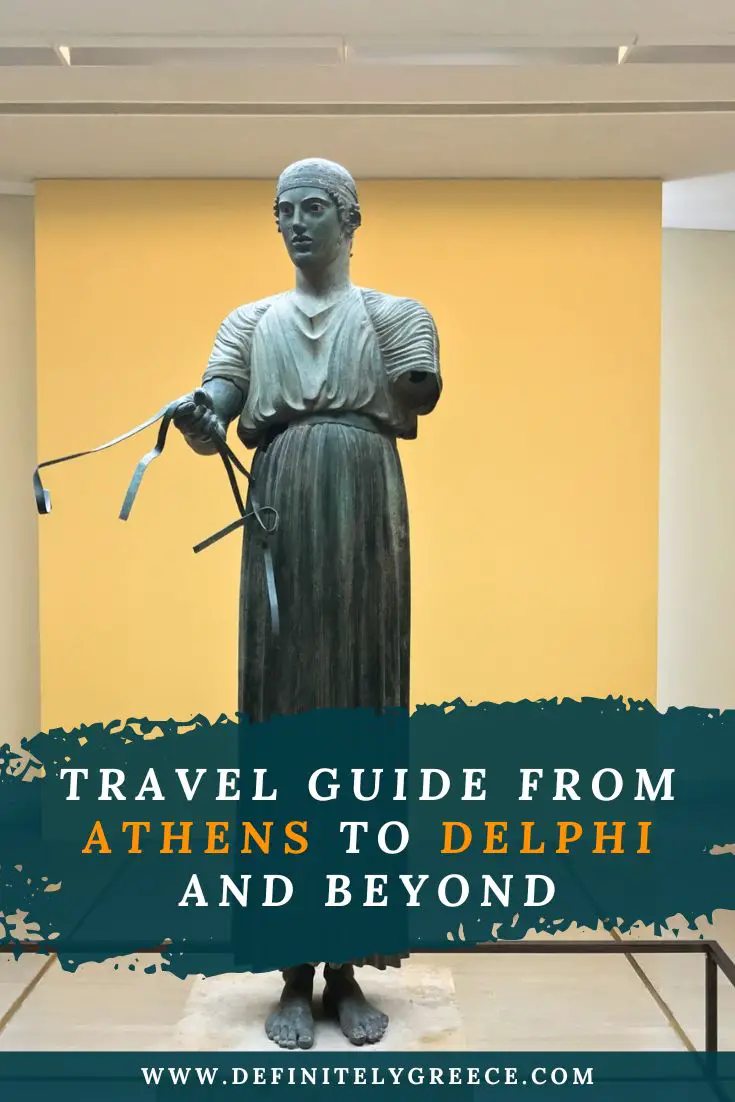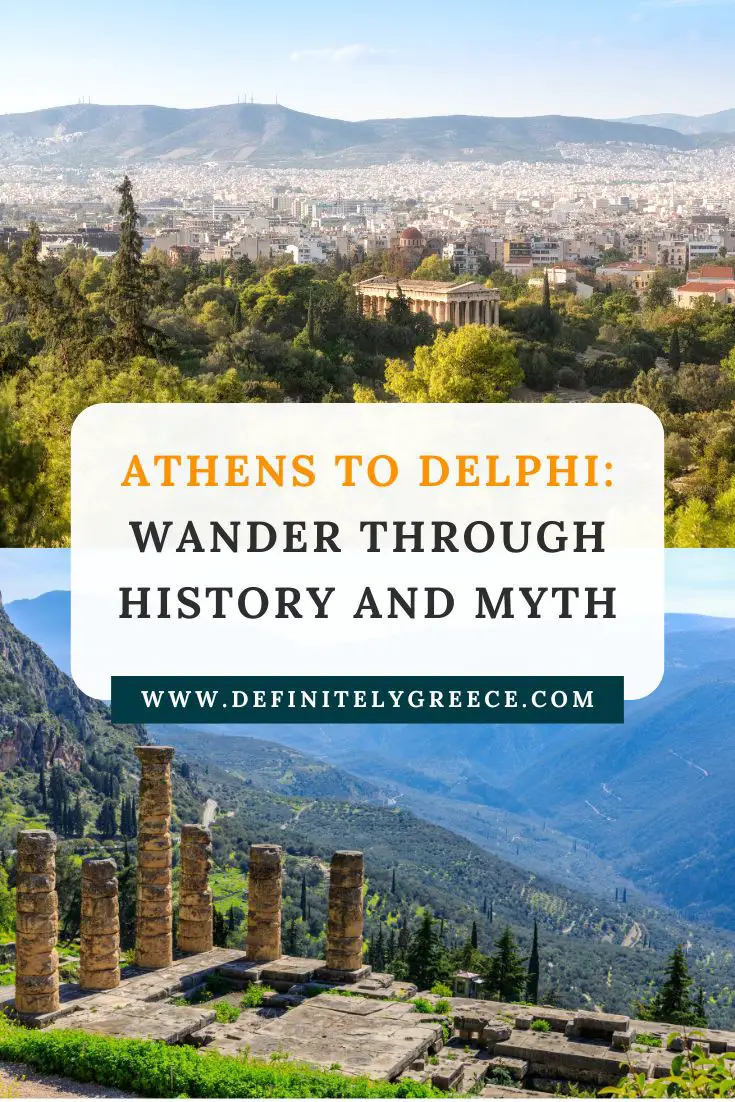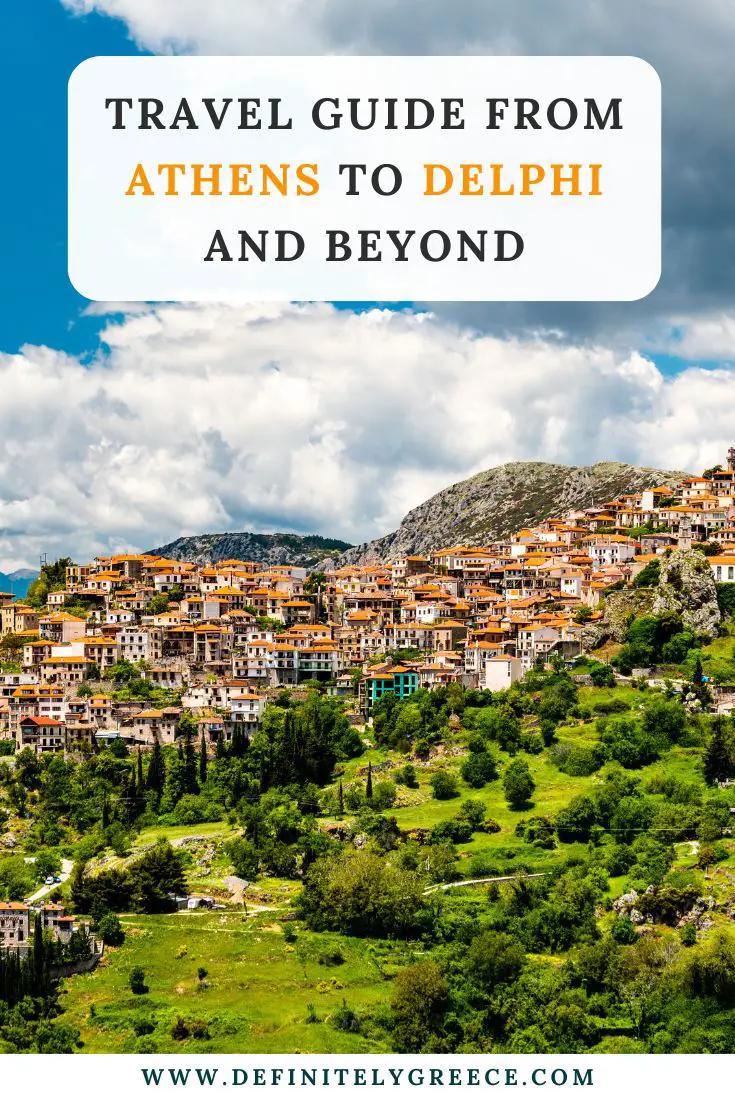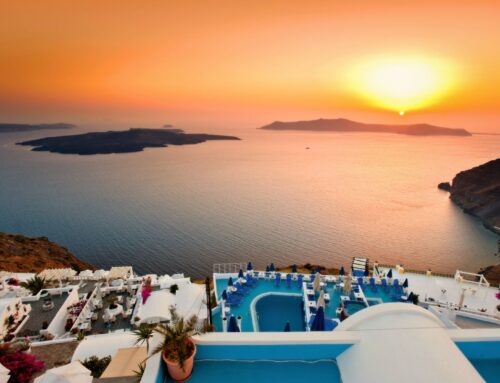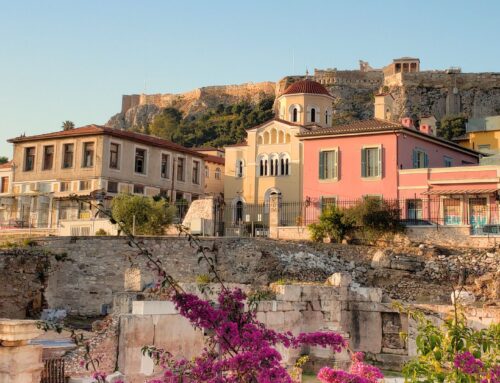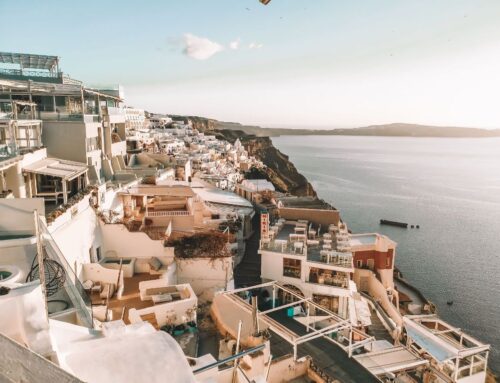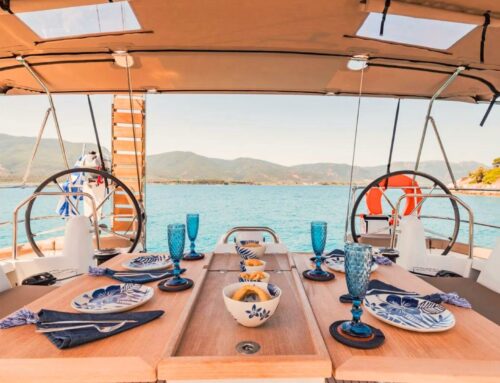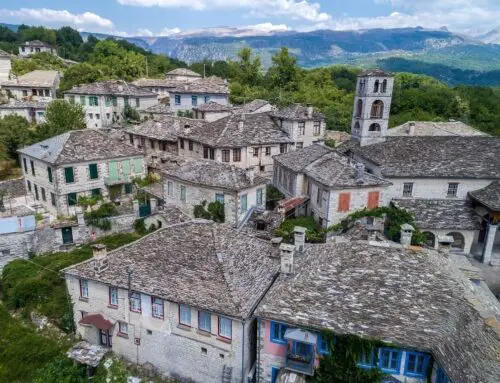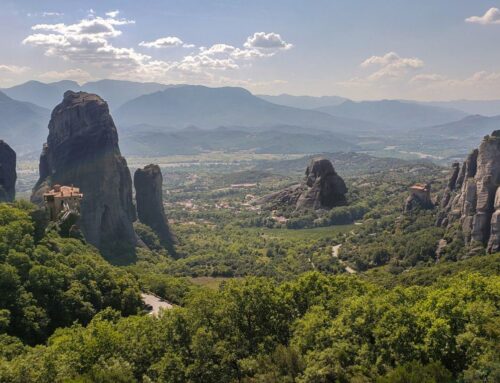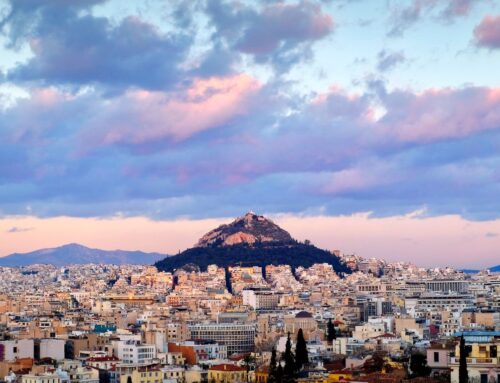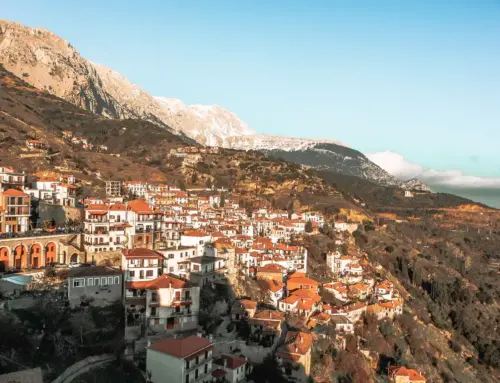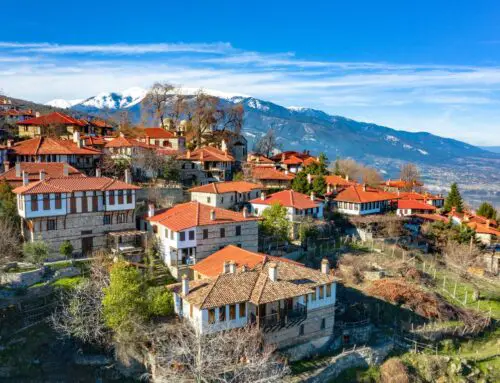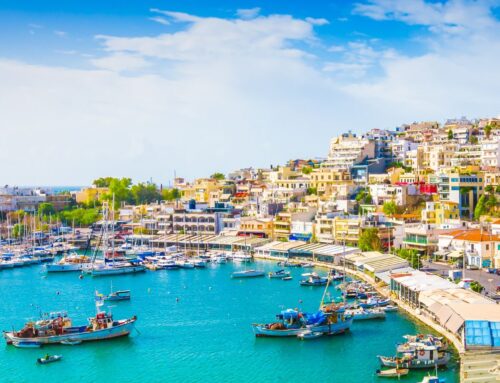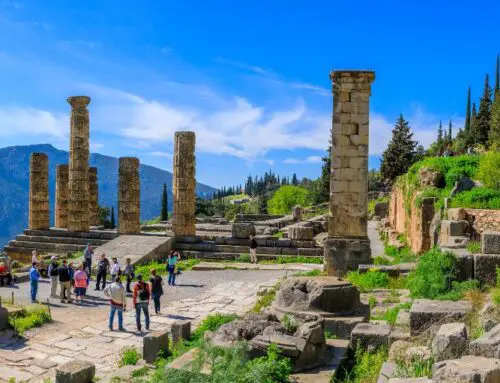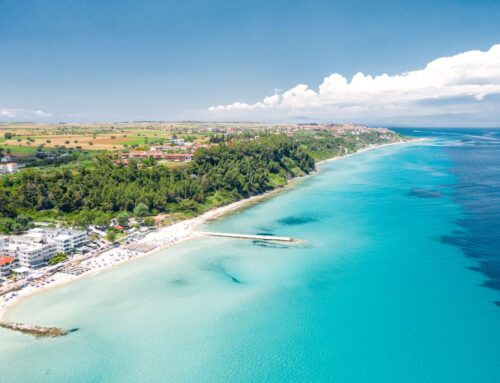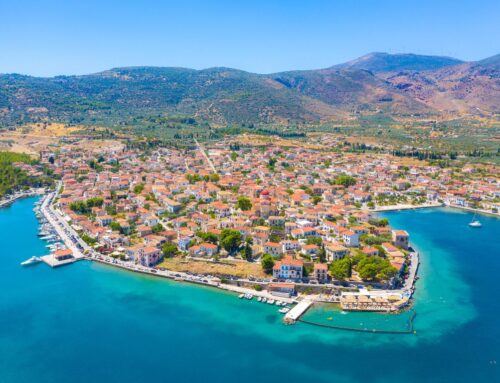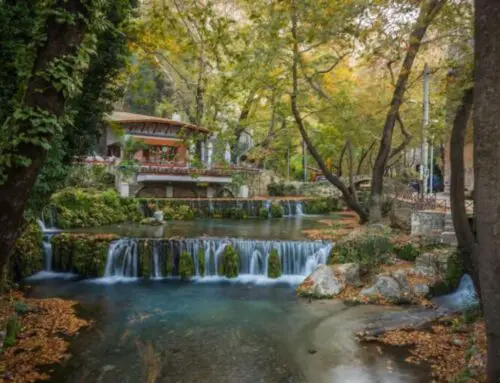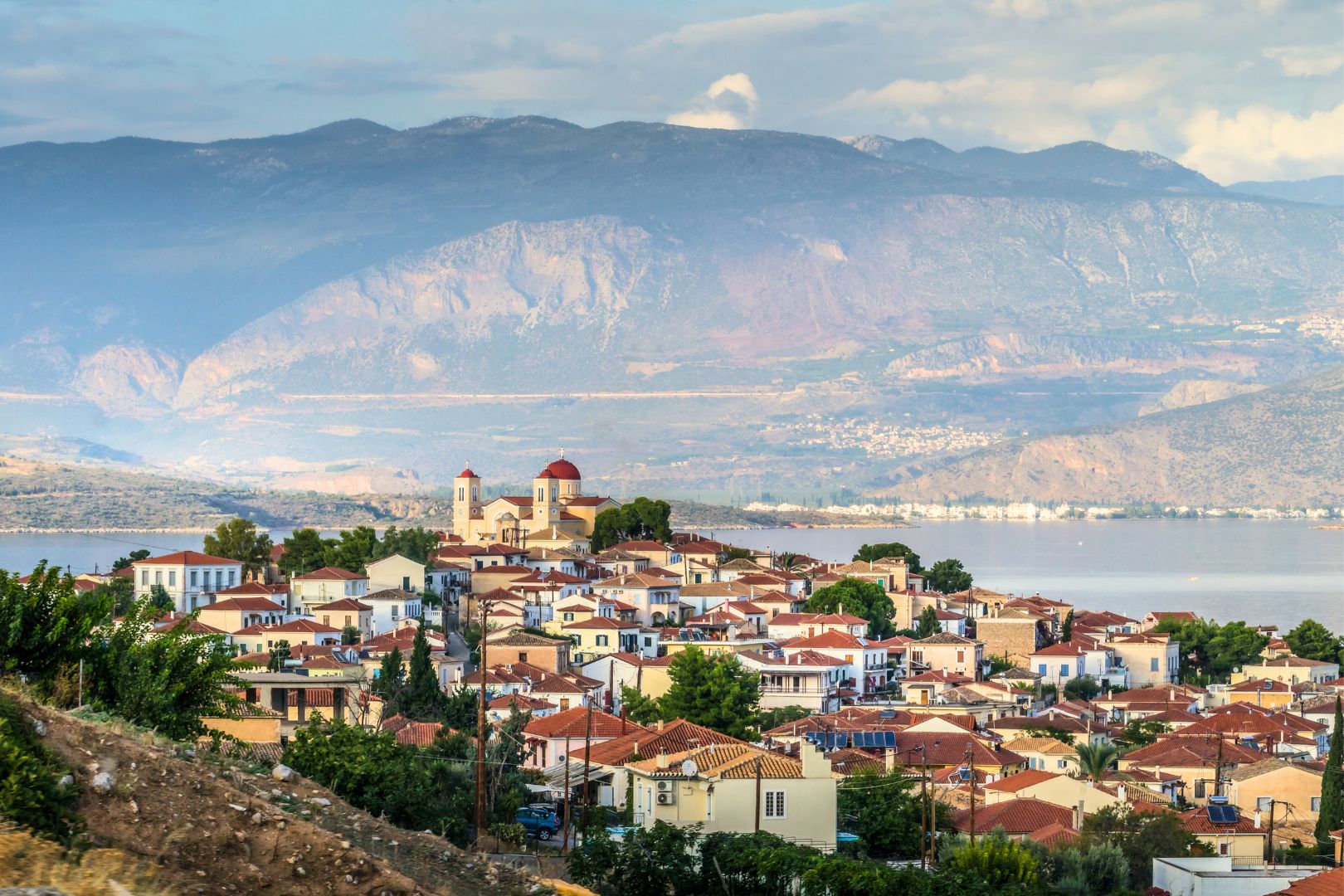
From Athens to Delphi: Wander Through Greek History and Myth
From Athens to Delphi: Wander Through Greek History and Myth

☞ Table of Contents:
Most online travel guides will tell you how far Delphi is from Athens. As if the road isn’t the journey itself.
This is why so many travelers overlook this trip. The tour will often stop in Athens’ urban center and resume at the archaeological sites of Delphi.
So much Greek history left unexplored. So many myths hidden in the in-between.
I want to take you on a different journey. To get “lost” for a while where mythology ends and history begins.
Don’t ask me how long it will take or when we’ll arrive… Just follow me.

Start in Athens
Athens, a city so small compared to so many other bustling capitals of the world, yet so vast. Athens is solitary, bustling, and often chaotic.
It bears centuries of history in its embrace, enchanting with its light and tales.
You must see it from a distance. You must allow Athens to reveal its secrets to you.
Or else you might just lose yourself in the layers of history from antiquity to the modern age, all mixed together in every stone, every wall, every building.
Do not compare it!
You would do it an injustice and shortchange yourself, who traveled from afar to see its sights.
Instead, climb the hill of the Acropolis and marvel at the Parthenon.
Walk to the Panathenaic Stadium and try to imagine Pheidippides finishing his final run after the Greek victory in the Battle of Marathon.
Visit Sounion with the Temple of Poseidon and read about the story of Aegeus and how the Aegean Sea you look upon today got its name.
Give yourself time to listen to these monuments that have withstood the ages. Stand for a moment under the Athenian sun that daily bathes its marbles.
Remember that here your steps tread the same paths as Socrates, Plato, and Aristotle.
Keep going; there is much more to see!
This small, this Great World! As Nobel laureate Odysseus Elytis wrote, offers endless wonders.
On The Way To Marathon
If I were with you on this journey, the first thing I’d point to as soon as we leave Athens is how close you pass to the site of the Battle of Marathon.
A battle that over 2500 years later continues to influence military tactics, sports, and even pop culture.
It all started in 490 B.C., when the powerful Persian army attacked Greece, aiming to extend its power across the Aegean Sea.
The Athenians sought help from the Spartans, sending the messenger Pheidippides. Believe it or not, running was an ancient profession that touched the spiritual realm. To be a Hemerodroms (long-distance day runner) like Pheidippides, was considered a holy and well-respected vocation. Although the Spartans agreed to help, they did not send aid in time (the 2,000 men they promised arrived at Marathon the day after the battle). They cited religious reasons, as they were celebrating the Carneia festival and could not march before the full moon.
In their first encounter with the Persian army at the Battle of Marathon, the Athenians proved victorious using a military tactic later known as the Pincer movement; the same tactic was used by General Patton against Rommel on the African front.
This is also the battle that inspired the famous 42-kilometer marathon run—the exact distance from Marathon to Athens.
At this same point, you will pass very close to Tatoi Forest on your left which holds a well-known secret.
The dense nature of Tatoi, sitting on the foothills of Mount Parnitha has been preserving royal history for centuries.
The 10,000-acre estate you will find there was once the residence of the Royal Family of Greece. In 1872 King George first bought the Tatoi estate and the humble 2-storey house within. Since then stables, warehouses, barracks, a winery, a cemetery, and countless other buildings joined the estate.
After the Royal Family evacuated in 1967, the estate was left to the elements. Abandoned by the Greek state, the grand buildings fell into neglect, slowly reclaimed by the surrounding forest and vandals who sought to keep pieces of the treasures within.
Thankfully, there is talk of bringing the estate back to its former glory for the public to enjoy.
There is no official date yet, but the 55 buildings, 27 monuments, and thousands of historical objects found within may very soon be housed in a brand-new palace museum.
Continuing further, just after passing Oinoi, you will see the sea and a part of Euboea to your right.
Before The Journey to Troy!
Let me tell you a story.
While movies about the 300 Spartans and the Trojan War continue to captivate audiences, your journey in this part of Greece can uncover stories even more compelling. Like Strabo, the famed geographer who traversed the world, you are on the brink of discovering Aulis.
Today, Aulis is a small town, but it was once a significant ancient Boeotian city. Historically, it is renowned as the port from which the Achaean fleet set sail for the Trojan War.
According to myth, while the Achaeans stayed in Aulis, Agamemnon received an oracle demanding he sacrifice his daughter, Iphigenia, at the temple of Artemis to secure favorable winds for the fleet. The great playwright Euripides immortalized this tale in his tragedy “Iphigenia at Aulis.” If you are fortunate, you might even catch a performance at the ancient theater of Epidaurus.
From here, I urge you to leave the National Highway and take the road leading to Thebes.
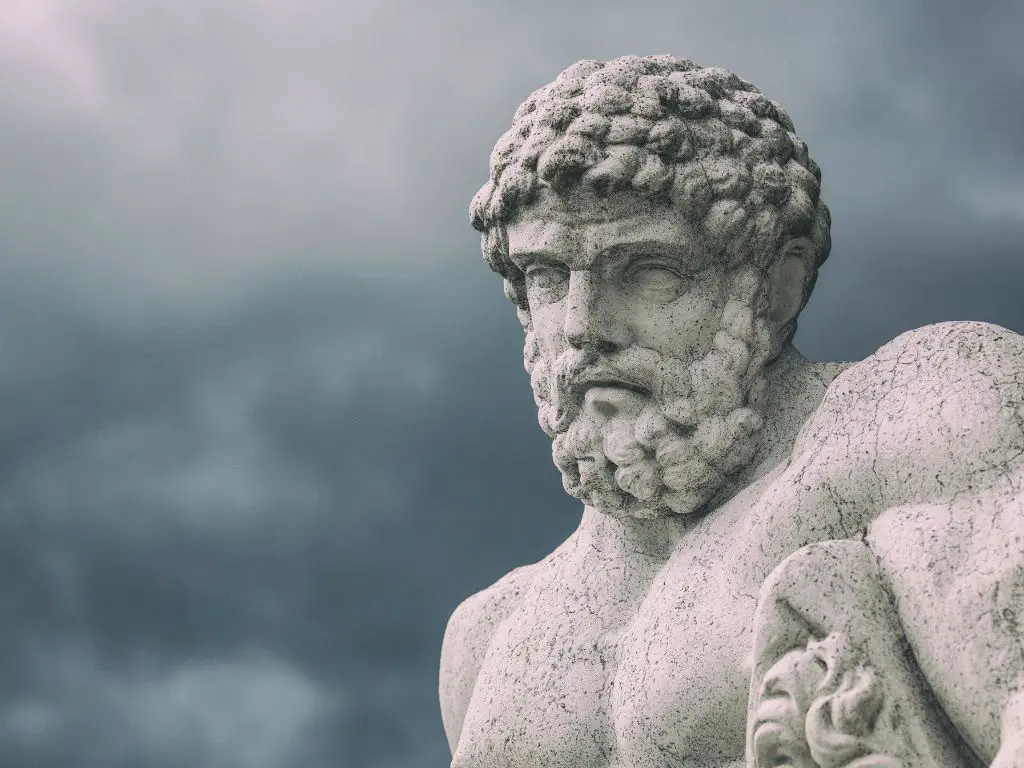
Thiva
Thiva, also known as Thebes is one of the oldest cities in Greece, steeped in some of the most captivating myths of Greek mythology.
Legend has it that its citadel, Cadmea, was founded by Cadmus, the son of Agenor. He arrived here from Phoenicia in search of his sister Europa, who had been abducted by Zeus.
Mythology tells us that Thebes is the birthplace of Hercules, Pentheus, Oedipus, and the enchanting god Dionysus.
The city’s rich mythological heritage provided the backdrop for profound tragedies, such as Sophocles’ “Oedipus Rex” and Euripides’ “The Bacchae.”
Hercules, the demigod son of Zeus and Alcmene, was renowned for his bravery and his twelve famous labors. The Thebans honored him with annual games held at a gymnasium dedicated to him.
As mentioned before, mythology and history often become intertwined! Today, Thebes is home to a modern museum that is well worth a visit if you want to unravel some of the mysteries wrapped in the in-between.
You have a long road ahead of you, keep going!
Aliartos
As you pass through Aliartos, you step into a city mentioned by Homer in the Iliad.
Its wealth stemmed from its strategic location between Orchomenos and Thebes and its fertile plains.
By the second half of the 6th century BC, Aliartos was minting silver coins.
According to myth, the prophet Tiresias is buried here.
You’ve heard of the nine Muses, right? They were the protectors of literature and the arts.
You are just a 30-minute drive from the famous Valley of the Muses at the foothills of Mount Helicon.
You might want to pick up some fruits and handmade pies from the local bakery before heading to the valley.
In the Valley of the Muses, traversed by the Permessus River, fir trees alternate with cypresses, vineyards with olive trees, and oaks. Ancient fragments blend with Byzantine and Frankish ruins.
At Aliartos, ditch the busy old national road connecting Thebes and Livadia. Take a winding route through the mountains, diving deep into the untamed nature of Mount Zagoras. Just 9 kilometers later, you’ll find Askri, one of Boeotia’s oldest villages. Myth has it that Askri was founded by the Aloadae, the mythical offspring of Poseidon.
The village of Askri was the home of Hesiod, a poet, rhapsodist, writer, and mythographer, considered the second greatest poet after Homer.
From here, follow the signs to the Valley of the Muses.
Back on The Road to Livadeia
Let me tell you about Livadeia, a city that, along with Amfissa (more on that later), feels like a journey back in time.
Livadeia, the capital of Boeotia with around 30,000 residents, sits at 200 meters elevation at the edge of the Kopais plain, with the Erkyna River flowing through. It’s surrounded by mountains: Parnassus to the north and Helicon to the south, where the old city once stood.
This city is blessed with history and myth, inspiring poets, painters, and sculptors for centuries. Known as Midea in ancient times, Livadeia was significant enough to earn a mention in Homer’s Iliad.
Livadeia was famous for the ancient Oracle of Trophonius, a mystical site that drew visitors seeking wisdom.
The Krya area, with the Erkyna River’s waters, was significant in antiquity for housing the famous Oracle of Trophonius Zeus. Today, you can see the sculptures of Spyros Gorgioti among the stone bridges. The same sculptor runs a delicious bakery just a few steps away.
Hungry?
Livadeia is a gastronomic paradise, renowned for its souvlaki. The local grill masters are experts at combining meats with fire and charcoal. Enjoy traditional souvlaki wraps or platters, fresh salads, tasty appetizers, handmade pies, and delicious fries. The menu also features kontosouvli and lamb chops, paired with excellent local wines.
For dessert, don’t miss the walnut cake, pancakes, rice pudding, and galaktoboureko—all made with high-quality ingredients.
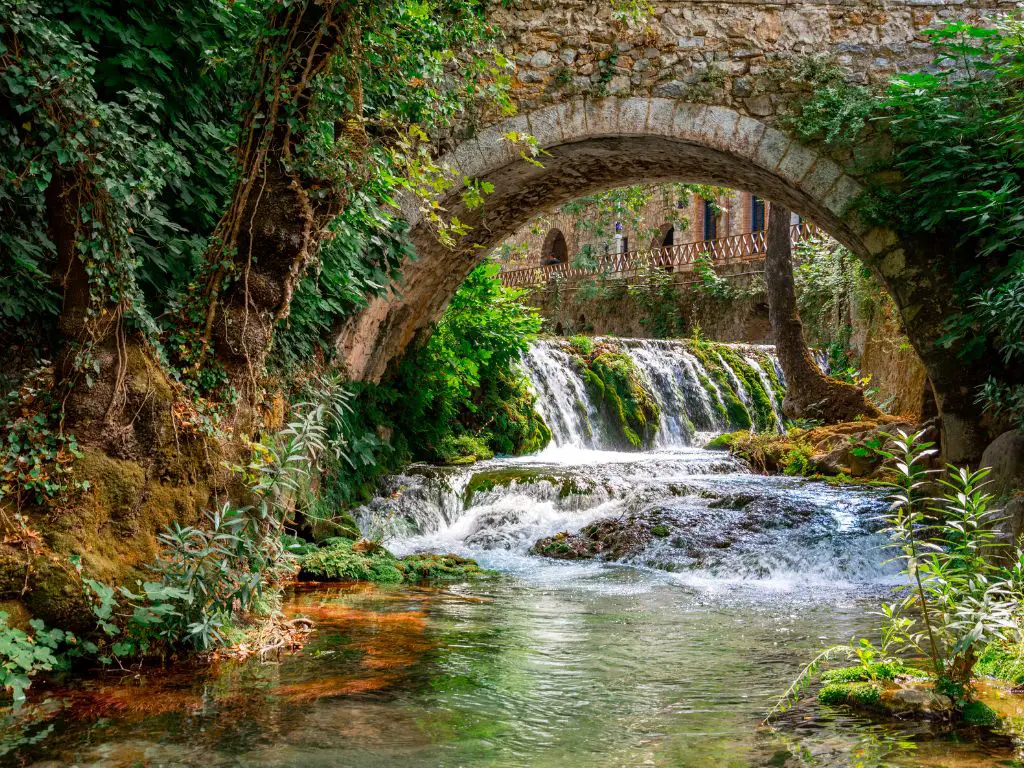
The Springs of Krya
The Springs of Krya is a breathtaking location where the Erkyna River flows. According to myth, Erkyna was a nymph, the daughter of Trophonius.
This enchanting area is packed with small waterfalls, dense greenery, stone bridges, and incredible natural beauty – everything you need for a relaxing midday break.
If you have some time to explore, don’t miss these sights around Krya:
- The Byzantine castle, expanded by the Franks and Catalans
- The stone theater of Krya
- The ruins of the Oracle of Trophonius
- The Tower of the Clock, a beacon built during the Frankish period.
Speaking of the Clock Tower, it’s a true landmark. In 1803, Lord Elgin gifted a clock to Livadeia to gain permission for excavations to find the Oracle of Trophonius.
The clock was installed on the tower to be visible from all points in the city. Yes, this is the same Elgin who took the Parthenon Marbles.
On The Road to Delphi
As you ascend towards Delphi, you’ll notice a significant landmark after a short tunnel: the Karakolithos Battle Monument.
This impressive monument lists the names of 134 victims of a German atrocity. But Karakolithos is also steeped in legend. It’s said to be where the mythical Sphinx stood, killing anyone who couldn’t answer her riddle: “What creature walks on four legs in the morning, two at noon, and three in the evening?”
Oedipus answered correctly, causing the Sphinx to leap to her death.
Now, behold Mount Parnassus!
After a scenic drive through lush trees, you’ll see the mountain’s majestic slopes.
Stop for a few breaths! You’ve reached a crossroads.
One way points to the village of Distomo, and the other to the Monastery of Hosios Loukas, a UNESCO World Heritage Site.
Renowned for its stunning architecture and invaluable mosaics, frescoes, and sculptures, this monastery is one of the Balkans’ most significant monastic complexes.
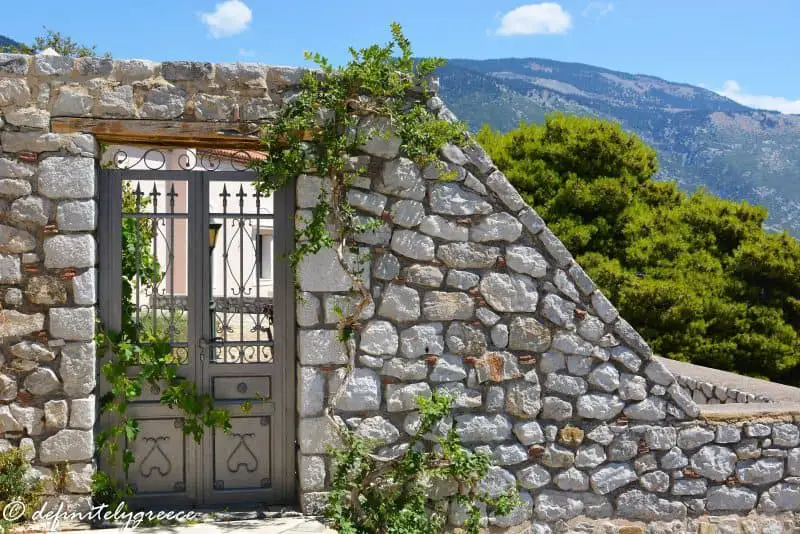
Distomo Mausoleum Memorial
High on Kanales Hill, 346 meters above Distomo, stands the Distomo Mausoleum, one of Greece’s most poignant and powerful monuments. This grand structure commemorates the 230 locals brutally executed by German Nazis in June 1944, just before the end of World War II.
Visiting the mausoleum, you’ll feel the weight of history and the sorrow of a community torn apart. The annual events held here honor these victims, including infants, who endured unimaginable horrors. A large marble slab etched with all their names stands as a silent testament to their sacrifice, while the surrounding landscape evokes a deep sense of awe and respect.
To truly grasp the profound history and collective grief of this martyred town, a visit to both the Distomo Mausoleum and the Museum of the Victims of Nazism is essential.

Up and UP Towards Arahova
As you wind your way up to Arahova, don’t be startled if a herd of sheep lazily crosses your path. This area is famous for its livestock, with sheepfolds scattered across the landscape.
Ever wondered about those small chapels by the roadside? Curiosity is a traveler’s best friend after all.
They mark the site of accidents, fatal or otherwise, as a sign of respect for what happened.
Keep your eyes curious! To your right, you’ll see more of Mount Parnassus, home to Greece’s largest and most popular ski resort. Yes, Greece has mountains and snow, and Parnassus is a prime example.
After the tunnel, look for a small clearing where you can safely pull over and soak in the breathtaking view of the gorge and Arahova.
Perched at 950 meters, Arahova is a traditional village with charming stone houses, narrow alleys, springs, and fresh air. Stroll through town and admire the old stone houses with their classic tiled roofs.
Arachova’s patron saint is Saint George, and the town comes alive for the famous Panigiraki festival in his honor. This three-day event, with roots in ancient Greek customs, features cannon shots and bell ringing, creating a vibrant atmosphere that echoes through the mountains.
Check out the stunning shots of the festival in this video.
Arachova is also a culinary delight with its many taverns. I recommend Kaplanis Tavern and Panagiota’s Tavern.
Sure, you could detour to the ski resort and uncover more scenic wonders, but let’s save that adventure. For now, we’re bound for Delphi and beyond… stick with me.
As we descend towards Delphi, get ready for a visual feast. The sprawling olive grove with the sea glimmering in the distance—dedicated to Apollo—is a sight to behold. This stretch from Arachova to Kirra, merging with the vast olive grove of Amfissa and centering around the sacred sites of Apollo and Athena in Delphi, is legendary.
Take your time, the view isn’t in a rush…

Exploring The Sites of Delphi
Ready for an adventure? Let’s dive into the stunning Delphic landscape, featuring the Pleistos Valley, the Crisaean Plain, and the sparkling gulf. Recognized by UNESCO in 1972 for its historical and natural significance, this area is forever linked to the ancient ruins of Delphi.
The ancient Greeks believed Delphi was the center of the world.
This is because, according to myth, Zeus sent two eagles—one east, one west—to find the earth’s navel. They met right here in Delphi.
Delphi was home to Greece’s most famous oracle, known far and wide, even in Syria and Armenia. Offerings from these distant lands have been found here. While Apollo was the main god, the site initially honored the Earth goddess, guarded by the dragon Python. Apollo, being the hero he is, defeated Python and set up his sanctuary.
Legend has it that it was the Cretans, guided by Apollo in dolphin form, who discovered this sacred spot.
Leave the flip-flops in the car! You’re about to hike a steep path, so sturdy, athletic shoes are a must. The archaeological site climbs a slope, offering jaw-dropping views of mountains and an endless olive grove as you go up. Feel the place’s energy and see why the ancient Greeks picked this spot for their grand constructions.
Before you reach the stadium, the highest point, turn around and soak in the sweeping view of all the monuments dotting the hillside. It’s simply breathtaking.
I recommend you brush up on the museum and archaeological site before you visit. Book a tour with a professional guide to get the full scoop on the history and grandeur, I promise you won’t regret it!
Must-sees include the Charioteer, a bronze statue celebrating a chariot team’s victory at the Pythian Games, and the enigmatic Sphinx.
Events in Delphi
Is it time for a story again?
Growing up near Delphi, I have some unforgettable memories. One summer, I visited my godmother in Chrissos, a charming village just below Delphi.
Chrissos, with its traditional homes and beautiful gardens, is a gem. The village features two quaint squares shaded by ancient plane trees and filled with traditional taverns.
One day, I stumbled upon a poster for a concert that night at the ancient stadium of Delphi. The youth orchestra and the legendary Goran Bregović were performing. I decided to stay.
That night was pure magic—under the stars, in the ancient stadium. It’s been 30 years, and I still remember it like it was yesterday.
These are the kinds of experiences you can have if you plan your trip around special events.
Imagine watching a performance at Epidaurus, the Herodeion, or even on a Greek island. It’s these moments that turn a trip into a lifelong memory.
The First Delphic Festivals
Flashback to May 9, 1927: Angelos and Eva Sikelianos reignited the flame of ancient Greek drama with the First Delphic Festivals in Delphi. Imagine watching Aeschylus’s “Prometheus Bound” in the ancient theater, followed by a reenactment of the Pyrrhic dance in the stadium. There were also athletic and dance displays, Byzantine music concerts, and a folk art exhibition.
Talk about reviving history!
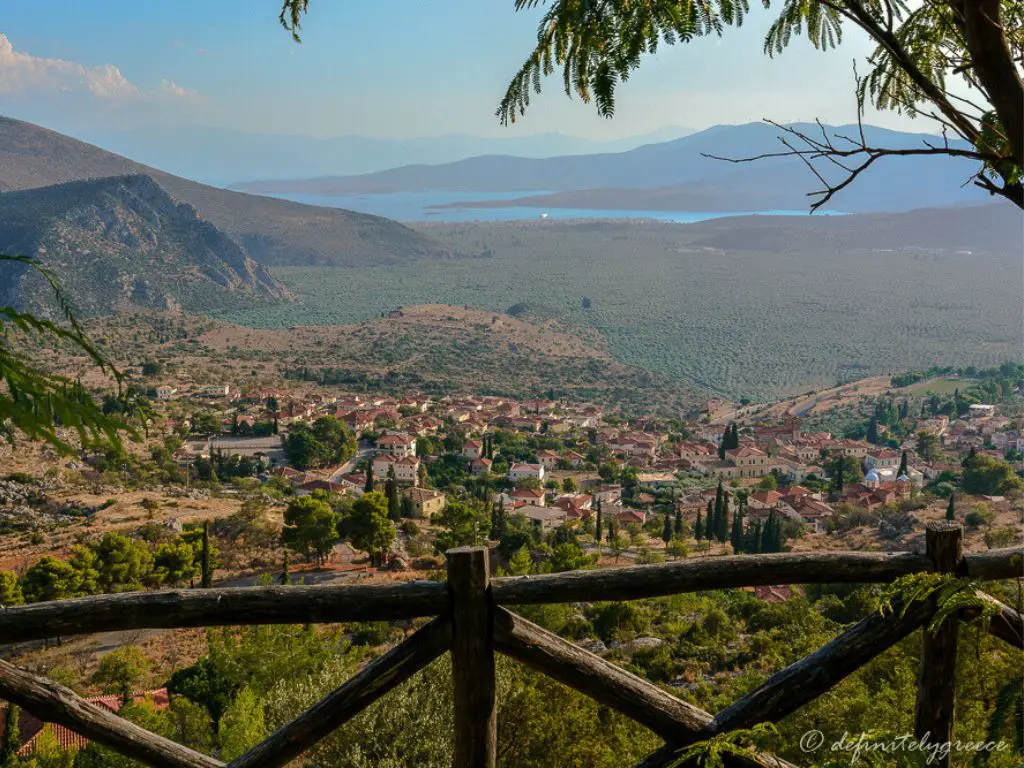
Dining in Delphi
Feeling peckish? Head to Bakchos! This family-run tavern blends traditional recipes with a modern twist and offers a view to die for. Theo and his family will serve you with a smile.
Looking for some hiking trails to get the appetite going? Check out the ancient trail that’s part of the European E4 path. There are plenty of trails around to quench your adventurous spirit.
So, now what?
We’ve seen Delphi’s sights… Is it time to head back? Not so fast!
This is where it gets interesting… “for the discerning traveler!” as they say.
If you want to see how locals live, feel the heartbeat of the area, and discover places not found in brochures… you need to go further.
As you descend from Delphi, follow the winding road through the stunning landscape.
Marvel at the silver-green olive groves—around 1.2 million trees producing the famous Amfissa olives. Look across the sea, and you’ll see the Peloponnese mountains—a story for another time perhaps.

A Magical Coffee Break
Midday got you craving a sip of coffee?
How about tasting some award-winning olive oil with a view of an olive grove?
At the big bend that looks like a bridge, you’ll see a sign for “Delfi Camping”
Trust me, take that turn!
In just two minutes, you’ll reach the entrance, where you’ll meet two cousins, both named Vassilis (yes, just like in “My Big Fat Greek Wedding”). It’s a Greek tradition to pass down names, so it’s common to have several family members with the same name.
You’ll find yourself on a gorgeous natural balcony under pine and mulberry trees, overlooking an endless olive grove. Ask to taste their olive oil and enjoy your coffee there—I recommend Greek coffee, but go with your favorite. This spot is perfect. I guarantee you’ll leave with some goodies and a ton of sunset photos.
Forget the clock! The beauty of travel lies in the journey, not the destination. Remember what our famous poet Cavafy said in his poem “Ithaca”—it’s all about the journey.
Want to hear it recited by Sean Connery with wonderful music by Vangelis? Listen here.

Don’t Skip Amfissa!
Tucked beneath its ancient fortress and framed by the towering mountains of Oeta and Giona, Amfissa is a hidden gem you can’t miss. This quaint town is surrounded by 4 of Greece’s 10 highest mountains and features lush gardens, orange groves, and surely doesn’t know the concept of traffic.
It’s one of the few towns in Greece entirely designated as an archaeological zone, where midday naps are a tradition and evenings burst into life.
Amfissa’s castle has seen it all—destroyed, rebuilt, besieged, and conquered by Philip II, Gauls, Bulgarians, Slavs, Franks, Catalans, and Ottomans. In medieval times, the imposing Castle of Salona was constructed on the ruins of the ancient acropolis, standing as the region’s most significant monument. Interestingly, the Romans couldn’t conquer Amfissa, so they declared it free and exempt from taxes.
Charmaina: The Tanner’s Quarter
Head to the northwestern part of town, to the foothills of Kokkinovrachos, and you’ll find the “Charmaina” district. Since pre-revolutionary times, this area has been the heart of tanning, with 42 traditional tanneries (Tabakika or Tabakaria) clustered around a communal fountain.
Tanning in Charmaina started before 1600, turning the town into a pre-industrial commercial hub thanks to its renowned vegetable tanning process. Amfissa’s high-quality leathers and parchments were exported to Rome and beyond.
In 1989, 42 old tanneries were declared preserved buildings, and in 2011, Charmaina won the European Excellence Award Eden 2011. Today, its softly lit alleys retain a unique charm, with the namesake café-tavern and the Municipal Art Gallery “Spyros Papaloukas” breathing life into the area. The Omoplinthos guesthouse is a shining example of how Charmaina could be revitalized for tourism.
Template Church of the Annunciation of The Virgin Mary
Don’t miss the Church of the Annunciation of the Virgin Mary, a stunning cross-in-square church with a dome. It’s one of Amfissa’s key landmarks, showcasing 19th-century ecclesiastical architecture. The distinguished painter Spyros Papaloukas was commissioned to paint its frescoes in 1926.
Amfissa has been inhabited since ancient times. Legend has it that Amfissa was the lover of Apollo—a fitting story given Delphi, the ancient center of the god of light, is just half an hour away.
Amfissa’s Must See Spots
The Renovated “Megalo Kafeneio 1929”
The newly renovated Megalo Kafeneio 1929 is back in business, playing jazz and funky tunes at a mellow volume from morning until late at night.
The café also spices things up with stand-up comedy nights and various performances. This spot captures the retro vibe that makes Amfissa so special. It feels like the locals have a pact to keep the spirit of the past alive, especially in the town center.
Coffee at Retro Cafe
When you’re in Amfissa, a coffee break at the Retro Cafe in the town square is a must. Make sure to shout out to Thymios, the friendly owner—”My friend!” will do —for a truly warm and memorable experience.
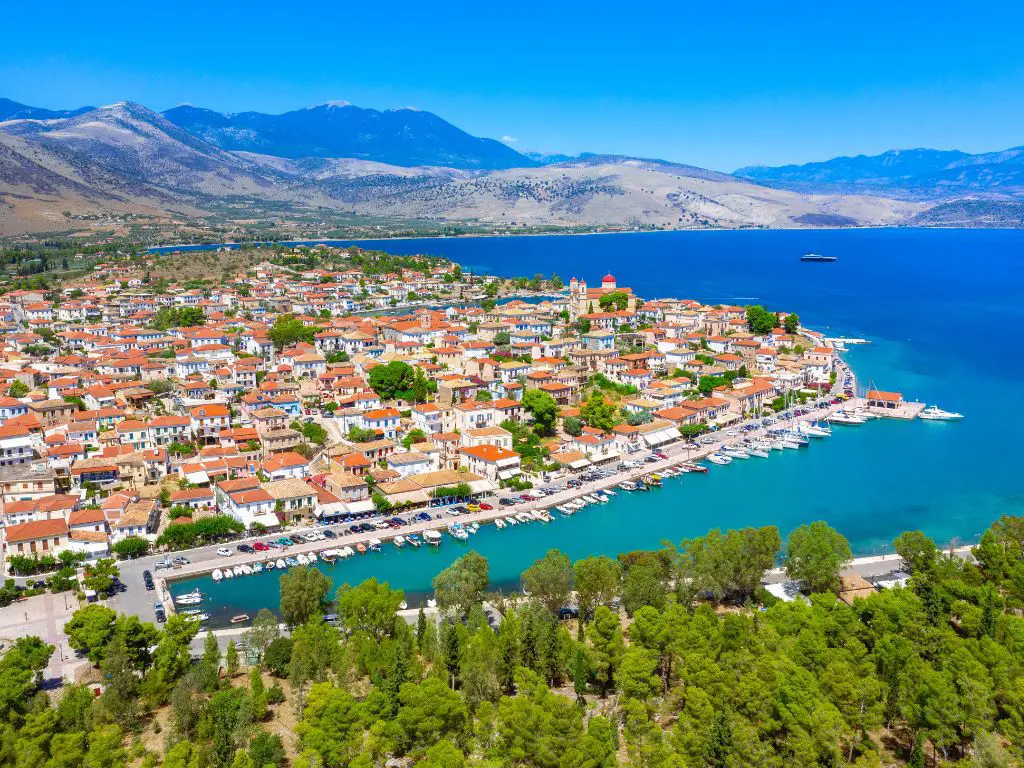
Onward to Galaxidi
Back on the road, head towards the sea, pass through the sprawling olive grove again, breeze through Itea, and hit a zigzagging coastal road.
Notice the burgundy soil on the hills? Don’t be surprised—that’s from the bauxite mines.
Fun fact: Bauxite is the primary source of aluminum.
The Bauxite Mines of Phocis
Bauxite mining in Phocis has been a big deal since before World War II, really taking off in the 1950s. Locals worked in the underground tunnels to extract the ore, making it one of Greece’s top export products.
If you want to see what their work was like stop by the Vagonetto Mining Park. There you will hop into a real “vagonetto” and ride through Gallery 850, a tunnel that was active until just 30 years ago. You’ll be geared up with a helmet and waterproof coat, and descend 200 meters underground. You will experience a virtual reality where miners tell you about their work and you see them in action. It’s an unforgettable journey back in time!
You’re just 20 minutes away from the picturesque town of Galaxidi!
We Made it To Galaxidi
Nestled quietly in the Crisaean Gulf, south of Phocis on the Corinthian Gulf, lies the historic maritime town of Galaxidi. Since 1978, it’s been recognized as a preserved settlement, and for good reason.
Galaxidi mirrors its charm in the calm, enclosed sea, dotted with rocky islets and quaint chapels. Cobblestone streets wind from the port, past grand stone mansions and proud captain’s houses with their unique pebble-paved courtyards, known as “aglies.” Notable buildings like the Tsallangiras building (now the Town Hall), the Parthenagogeio (a girls’ school built in 1880), and the Bourzeiko building still stand proudly, preserving their historical beauty. Some of these mansions have been transformed into atmospheric guesthouses, offering a stay steeped in history and elegance.
Long before the Greek War of Independence, Galaxidians were masters of the sea. Despite repeated devastations by the Turks, the town’s maritime prowess shone brightly post-liberation. By the 19th century, Galaxidi’s sailing ships ruled the Mediterranean, reaching destinations like Livorno, Marseille, the Black Sea, the Sea of Azov, the Danube, and even England.
At its peak in the late 19th century, Galaxidi had around 300 ships. The town saw the establishment of a Naval School, the proliferation of shipyards, and Galaxidian shipping agents in major European ports. However, the rise of steamships in the early 20th century and the construction of the Corinth Canal marked the end of this golden era, as the new technology and routes bypassed Galaxidi.
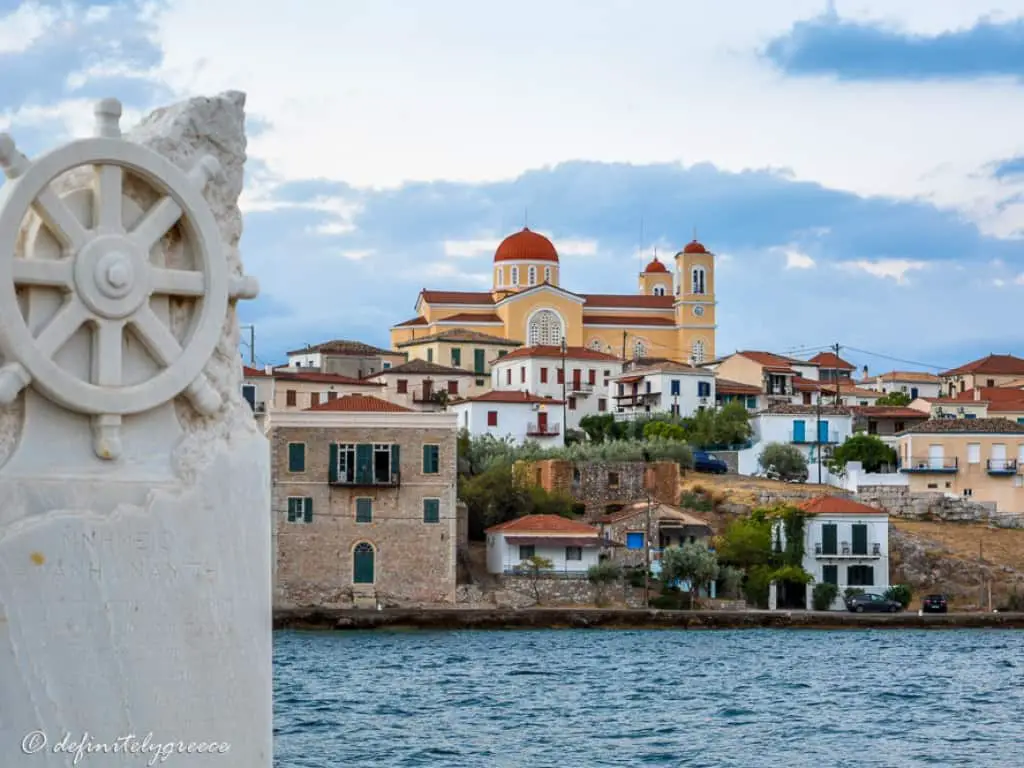
Must See Attractions in Galaxidi
Don’t miss the Naval and Historical Museum, the first of its kind in Greece, housed in a building from 1870.
The port still whispers tales of its glory days, filled with bracers, schooners, and luggers, while women mended sails in the specially designed single-room salons of the mansions.
Also, make sure to visit the international monument to the “Woman of the Seafarer,” honoring the women who played a crucial role in supporting Galaxidi’s maritime legacy.
Where to Stay in Galaxidi
Nostos offers a cozy and inviting atmosphere that combines traditional charm with modern comforts. It’s the perfect place to unwind and soak in the local culture.
In 2003, Costas & Chrisoula Papalexi took over Ganimede from the previous owner, Bruno Perrocco, who had been offering high-quality services since 1966. Chrisoula has continued this tradition with her homemade jams and chutneys, based on recipes inherited from Bruno. Over the years, she has added new flavors and aromas, creating a delightful breakfast experience for guests. The hotel has earned a great international reputation, with visitors from all over the world coming to enjoy its unique charm and hospitality.
Where to Dine in Galaxidi
For a true taste of Galaxidi, don’t miss Maritsa’s. This spot is beloved for its delicious seafood and authentic local dishes. If you’re in the mood for something different, there are also several modern cuisine options that put a contemporary spin on traditional flavors.
Steki Family is a popular seaside restaurant with a perfect outdoor courtyard for enjoying its delectable dishes, including the best dolmades we’ve ever tasted in July 2022.
Ab oVo is a charming family-run restaurant where you can savor rich Greek flavors in dishes prepared with fresh, local ingredients. Its beautiful outdoor garden, adorned with roses, adds to the delightful dining experience.
O Bebelis, situated close to the port and main square, offers a cozy outdoor seating area in one of Galaxidi’s typical alleys. The menu is designed for sharing, making it ideal for larger groups to sample a variety of dishes.
Skeletovrachos, set in the picturesque port, is run by a father-and-son team specializing in fresh, local seafood, with vegetarian options available.
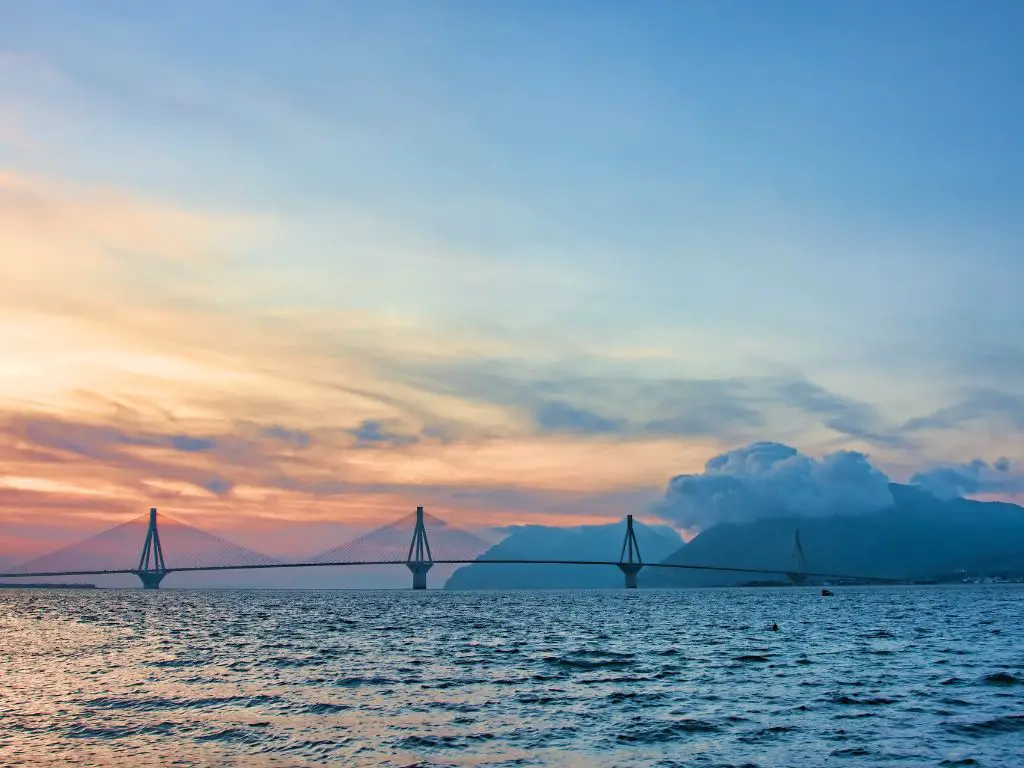
Where to now?
Venture to the stunning islands of Lefkada and the Ionian Sea for breathtaking views and serene beaches. Head north to explore the vibrant city of Ioannina and the charming Zagorochoria villages in Epirus, known for their stone architecture and scenic landscapes.
Alternatively, travel south, cross the Rio-Antirrio bridge, and visit the historic site of ancient Olympia. Or, you could always make your way back to Athens, the heart of Greece.
Chat with locals, wander down unfamiliar alleys, and discover hidden treasures that aren’t in any guidebook. That’s how I’ve uncovered the gems I’m sharing with you.
If this way of exploring appeals to you, get in touch to craft your very own personalized travel experience.
Happy travels!
*Disclaimer: This page might include affiliate links. If you decide to book something through one of them, I might get a little bonus, but it won't cost you anything extra.*


